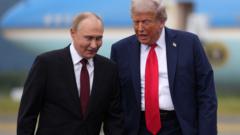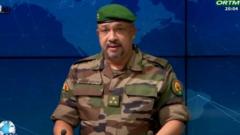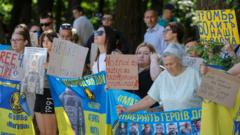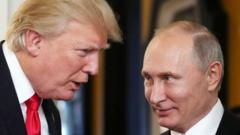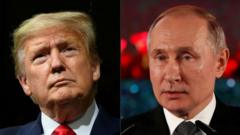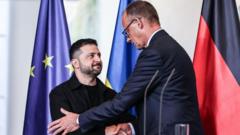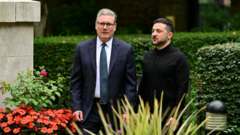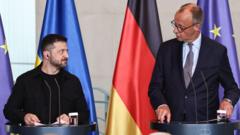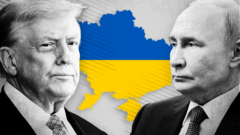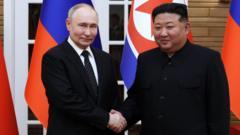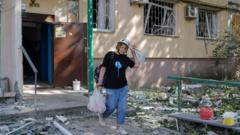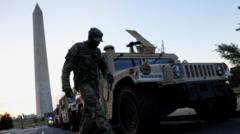This article delves into key moments of the Alaska summit, highlighting the lack of immediate resolutions on the Ukraine conflict despite a warm diplomatic engagement between the leaders.
**Unexpected Developments from Alaska Summit: What Lies Ahead for Trump and Putin**

**Unexpected Developments from Alaska Summit: What Lies Ahead for Trump and Putin**
An exploration of the recent summit between U.S. President Donald Trump and Russian President Vladimir Putin in Alaska, revealing new dynamics in international relations.
In a surprising turn of events, U.S. President Donald Trump and Russian President Vladimir Putin met for a high-profile summit in Alaska, intended to foster discussions aimed at resolving the ongoing Ukraine crisis. Despite the anticipation surrounding the almost three-hour meeting, it appears to have generated more questions than answers, particularly around the prospect of peace.
Upon arrival in Alaska, Putin received a historic welcome, marked by a red carpet and applause from Trump, illustrating a potential thaw in relations that had severely deteriorated since Russia’s invasion of Ukraine in 2022. The unfolding moment not only highlighted the political significance of the meeting but also served to boost Putin’s image on the global stage, transitioning from international pariah to welcomed guest. His decision to travel in Trump’s limousine rather than his official vehicle underscored this newfound camaraderie.
However, the summit was not without tension. As Putin was met with queries from journalists, including pointed questions about civilian casualties in Ukraine—topics he seldom faces domestically—his responses were evasive, often met with silence or cryptic smiles. The absence of a press conference following their private discussion raised eyebrows; instead, both leaders delivered brief statements sans questions from the press.
Putin's remarks included an acknowledgment of a possible agreement reached in Alaska, though they hinted at demands for a resolution that may be unrealistic for Ukraine, including recognizing annexations and accepting a neutral stance. His phrasing suggested that the root causes of the conflict would need to be addressed, a statement likely to alarm Ukraine and its allies.
Curiously, Trump neglected to address Ukraine in his own commentary, focusing instead on vague notions of progress. While he hinted at an end to hostilities, he provided no concrete steps nor any details about further negotiations. His statement lacked the usual certitude associated with his leadership, a reflection of the complexities of the ongoing crisis.
Despite the lack of substantive advancements, the summit concluded with both leaders leaving the door open for future dialogue, speculating about another meeting in Moscow, although specifics remained unclear. As the two leaders exchanged pleasantries, the image of cooperation broadcasted across social media belied the absence of any solid agreements on the pressing issues.
As the international community continues to scrutinize the ramifications of this meeting, the prevailing sentiment seems to be cautious optimism, with glimpses of potential rapprochement obscured by the ongoing strife in Ukraine and the significant challenges ahead for both leaders.
Upon arrival in Alaska, Putin received a historic welcome, marked by a red carpet and applause from Trump, illustrating a potential thaw in relations that had severely deteriorated since Russia’s invasion of Ukraine in 2022. The unfolding moment not only highlighted the political significance of the meeting but also served to boost Putin’s image on the global stage, transitioning from international pariah to welcomed guest. His decision to travel in Trump’s limousine rather than his official vehicle underscored this newfound camaraderie.
However, the summit was not without tension. As Putin was met with queries from journalists, including pointed questions about civilian casualties in Ukraine—topics he seldom faces domestically—his responses were evasive, often met with silence or cryptic smiles. The absence of a press conference following their private discussion raised eyebrows; instead, both leaders delivered brief statements sans questions from the press.
Putin's remarks included an acknowledgment of a possible agreement reached in Alaska, though they hinted at demands for a resolution that may be unrealistic for Ukraine, including recognizing annexations and accepting a neutral stance. His phrasing suggested that the root causes of the conflict would need to be addressed, a statement likely to alarm Ukraine and its allies.
Curiously, Trump neglected to address Ukraine in his own commentary, focusing instead on vague notions of progress. While he hinted at an end to hostilities, he provided no concrete steps nor any details about further negotiations. His statement lacked the usual certitude associated with his leadership, a reflection of the complexities of the ongoing crisis.
Despite the lack of substantive advancements, the summit concluded with both leaders leaving the door open for future dialogue, speculating about another meeting in Moscow, although specifics remained unclear. As the two leaders exchanged pleasantries, the image of cooperation broadcasted across social media belied the absence of any solid agreements on the pressing issues.
As the international community continues to scrutinize the ramifications of this meeting, the prevailing sentiment seems to be cautious optimism, with glimpses of potential rapprochement obscured by the ongoing strife in Ukraine and the significant challenges ahead for both leaders.

